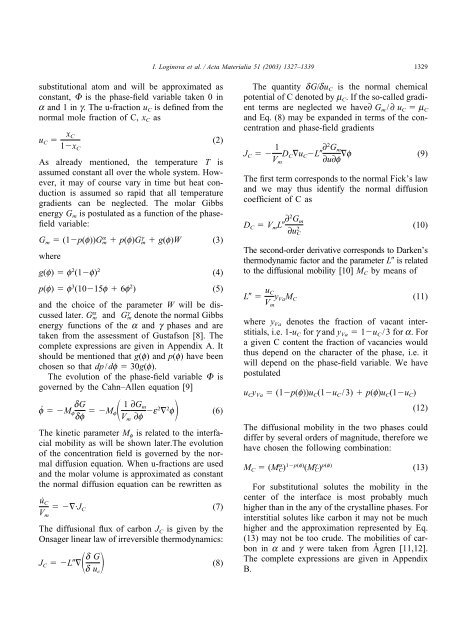Phase-field modeling of diffusion controlled phase ... - KTH Mechanics
Phase-field modeling of diffusion controlled phase ... - KTH Mechanics
Phase-field modeling of diffusion controlled phase ... - KTH Mechanics
You also want an ePaper? Increase the reach of your titles
YUMPU automatically turns print PDFs into web optimized ePapers that Google loves.
I. Loginova et al. / Acta Materialia 51 (2003) 1327–13391329substitutional atom and will be approximated asconstant, is the <strong>phase</strong>-<strong>field</strong> variable taken 0 ina and 1 in g. The u-fraction u C is defined from thenormal mole fraction <strong>of</strong> C, x C asu C x C(2)1x CAs already mentioned, the temperature T isassumed constant all over the whole system. However,it may <strong>of</strong> course vary in time but heat conductionis assumed so rapid that all temperaturegradients can be neglected. The molar Gibbsenergy G m is postulated as a function <strong>of</strong> the <strong>phase</strong><strong>field</strong>variable:G m (1p(f))G a m p(f)G g m g(f)W (3)whereg(f) f 2 (1f) 2 (4)p(f) f 3 (1015f 6f 2 ) (5)and the choice <strong>of</strong> the parameter W will be discussedlater. G a m and G g m denote the normal Gibbsenergy functions <strong>of</strong> the a and g <strong>phase</strong>s and aretaken from the assessment <strong>of</strong> Gustafson [8]. Thecomplete expressions are given in Appendix A. Itshould be mentioned that g(f) and p(f) have beenchosen so that dp/df 30g(f).The evolution <strong>of</strong> the <strong>phase</strong>-<strong>field</strong> variable isgoverned by the Cahn–Allen equation [9](6)ḟ M fdGdf M f 1 V m∂G m∂f e2 2 fThe kinetic parameter M f is related to the interfacialmobility as will be shown later.The evolution<strong>of</strong> the concentration <strong>field</strong> is governed by the normal<strong>diffusion</strong> equation. When u-fractions are usedand the molar volume is approximated as constantthe normal <strong>diffusion</strong> equation can be rewritten asu˙ C·JVC (7)mThe <strong>diffusion</strong>al flux <strong>of</strong> carbon J C is given by theOnsager linear law <strong>of</strong> irreversible thermodynamics:J C L d Gd u c (8)The quantity dG/du C is the normal chemicalpotential <strong>of</strong> C denoted by m C . If the so-called gradientterms are neglected we have∂ G m /∂ u C m Cand Eq. (8) may be expanded in terms <strong>of</strong> the concentrationand <strong>phase</strong>-<strong>field</strong> gradientsJ C 1 DV C u C L ∂2 G mf (9)m ∂u∂fThe first term corresponds to the normal Fick’s lawand we may thus identify the normal <strong>diffusion</strong>coefficient <strong>of</strong> C asD C V m L ∂2 G m∂u 2 C(10)The second-order derivative corresponds to Darken’sthermodynamic factor and the parameter L is relatedto the <strong>diffusion</strong>al mobility [10] M C by means <strong>of</strong>L u CV my Va M C (11)where y Va denotes the fraction <strong>of</strong> vacant interstitials,i.e. 1-u C for g and y Va 1u C /3 for a. Fora given C content the fraction <strong>of</strong> vacancies wouldthus depend on the character <strong>of</strong> the <strong>phase</strong>, i.e. itwill depend on the <strong>phase</strong>-<strong>field</strong> variable. We havepostulatedu C y Va (1p(f))u C (1u C /3) p(f)u C (1u C )(12)The <strong>diffusion</strong>al mobility in the two <strong>phase</strong>s coulddiffer by several orders <strong>of</strong> magnitude, therefore wehave chosen the following combination:M C (M a C) 1p(f) (M g C) p(f) (13)For substitutional solutes the mobility in thecenter <strong>of</strong> the interface is most probably muchhigher than in the any <strong>of</strong> the crystalline <strong>phase</strong>s. Forinterstitial solutes like carbon it may not be muchhigher and the approximation represented by Eq.(13) may not be too crude. The mobilities <strong>of</strong> carbonin a and g were taken from Ågren [11,12].The complete expressions are given in AppendixB.
















